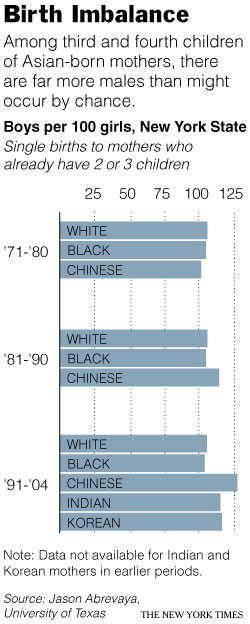June 17, 2009
Written by C.N.
Some Asian Groups Favoring Boys in Births
It’s a well known and documented fact that in almost all Asian cultures, boys are systematically valued more than girls. Based on centuries of institutionalized patriarchy and traditional cultural practices, most Asian families would rather have children who are boys than girls. This gender bias is one of the reasons why an overwhelming majority of children given up for adoption in Asian countries are girls. This bias has also led to growing gender imbalances in many Asian countries, with some analysts predicting that such a gender imbalance may evolve into a threat to national security as this overpopulation of males become adults.
Here in the U.S., we might think that things are different among Asian Americans. That is, being a part of American society and within its social norms of gender equality, Asian Americans would have more “modern” views about the value of boys and girls so that there would not be any kind of systematic preference of one gender over another when it comes to our children. However, as the New York Times reports, recent Census data shows that at least among Indian Americans, Chinese Americans, and Korean Americans, there is a notable gender imbalance among their children in which boys are much more common than girls:
In general, more boys than girls are born in the United States, by a ratio of 1.05 to 1. But among American families of Chinese, Korean and Indian descent, the likelihood of having a boy increased to 1.17 to 1 if the first child was a girl, according to the Columbia economists. If the first two children were girls, the ratio for a third child was 1.51 to 1 — or about 50 percent greater — in favor of boys. . . .
Demographers say the statistical deviation among Asian-American families is significant, and they believe it reflects not only a preference for male children, but a growing tendency for these families to embrace sex-selection techniques, like in vitro fertilization and sperm sorting, or abortion. . . .
Dr. Norbert Gleicher, medical director of the Center for Human Reproduction, a fertility and sex-selection clinic in New York and Chicago, said that from his experience, people were more inclined to want female children, except for Asians and Middle Easterners. . . . The Fertility Institutes, which does not offer abortions, has unabashedly advertised its services in Indian- and Chinese-language newspapers in the United States. . . .
Efforts by clinics to appeal to Indian families in the United States provoked criticism and some community introspection in 2001. Some newspapers and magazines that ran advertisements promoting the clinics, which offered sex-selection procedures, expressed regret at the perpetuation of what critics regard as a misogynistic practice.

This emerging gender imbalance and “son-biased” sex ratio (illustrated in the accompanying New York Times graphic on the right) seems to reflect one fundamental point — that many Asian Americans still have very direct and strong family and cultural connections to their ancestral country. These traditional cultural ties can manifest themselves directly in the form of Asian immigrants still having the “son is superior” mentality that leads them to favor having boys more than girls.
Or, as the New York Times article also mentions, the other way that these traditional cultural ties become exemplified can be that even younger Asian American immigrant couples accept the U.S.’s norms of gender equality, various pressures from family, relatives, or friends in their ancestral Asian country lead them to favor boys over girls. As one example of this, perhaps couples in this situation have parents in the home country who will only give inheritance to male descendants and not female ones.
Ultimately, these demographic patterns (at least among Indian Americans, Chinese Americans, and Korean Americans) show us that the connections between Asia and America run deeper than just geographic distance.
That said, we should also recognize that this article and research studies that provide the basis of these demographic trends all note that these findings seem to be limited to Asian immigrant couples in which both spouses are foreign-born. In other words, there does not seem to be any data or evidence that this trend exists among Asian American couples in which both spouses are U.S.-born.
This last point goes to show just how powerful a force American assimilation is in the lives of most Asian Americans.
Author Citation
Copyright © 2001- by C.N. Le. Some rights reserved. 
Suggested reference: Le, C.N. . "Some Asian Groups Favoring Boys in Births" Asian-Nation: The Landscape of Asian America. <https://www.asian-nation.org/headlines/2009/06/some-asian-groups-favoring-boys-in-births/> ().
Short URL: https://www.asian-nation.org/headlines/?p=1331
Tags:
Translate Into Another Language![]()
